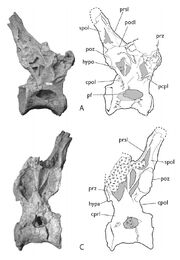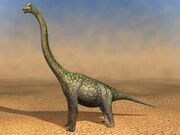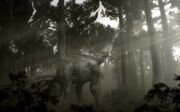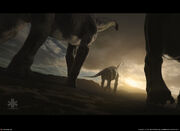Sauroposeidon protelis is a genus of Brachiosaurid sauropod dinosaur. It is only known from four neck vertebrae that were found in South-Eastern Oklahoma. The fossils were discovered in an early Cretaceous period rock layer, a time-span in which sauropods were thought to have greatly dimminished in both size and number, making Sauroposeidon the last great Sauropod on the North American Continent. When the fossils were discovered in 1993 in Atoka County in Oklahoma, their size and time of origin caused them to be missclassified as petrified tree trunks, until 1999, when a further study revealed the truth. When this was realised, it caused a media frenzy.

Sauroposeidon Vertebrae
Palecological analysis shows that this Sauroposeidon lived on the shore of the Gulf of Mexico, which at the time streched into oklahoma, near the mouth of a great river. Like all other Brachiosaurids, it was a quadropedal herbivore with front legs longer that the rear legs, a build similar to a modern giraffe. Extrapolations based on its more completely known relative Brachiosaurus indicate that the head of Sauroposeidon could reach 18 m in height with its neck extended, making it the tallest known dinosaur. With an estimated length of up to 34 m (112 ft) and a mass of 50–60 t (55–66 short tons), it also ranks among the longest and heaviest.
Name Origin
The name comes from Greek sauros, meaning lizard, and the Greek sea god, Poseidon, who was also the god of earthquakes, often being called Ennosigaios, "The Earth Shaker". This is a reference to the notion that this sauropod was so massive, when it walked the earth shaked.
The species name, protelis, also comes from Ancient Greek, meaning "Perfect before the End", refering to Sauroposeidon's status as the Last Great Sauropod.
Size
The press release of the discovery in 1999 immediatly gathered international media attention, which led to many innacurate reports of "the largest dinosaur ever!" While it is true that Sauroposeidon is probably the tallest known dinosaur, it is neither the longest or most massive. Argentinosaurus is a better candidate for this title (presuming we ignore the controversial Amphicoelias, which most scientists do), though weak fossil remains for both Sauroposeidon and Argentinosaurus make exact ranking impossible
The Sauroposeidon find consisted of only four, elongated, mid-cervical vertebrae, numbers 5-8.The largest vertibrae measured an astonishing 1.4 m., or 4.6 feet, making it the largest sauropod vertibrae ever. Examination of the bones revealed that they were honeycombed with tiny air pockets to reduce weight, to make lifting the neck much easier. The cervical ribs were remakably long as well, with the longest cervical rib of any sauropod on vertebra 6, measuring 3.42 m. (11.2 ft.).

Estimates of Sauroposeidon's size are based on a comparison between the four Sauroposeidon vertebrae and the vertebrae of the HM SII specimen of Giraffatitan brancai, located in the Humboldt Museum in Berlin. The HM SII is the most complete brachiosaur known, though since it is composed of pieces from different individuals its proportions may not be totally accurate. Comparisons to the other brachiosaurid relatives of Sauroposeidon are difficult due to limited remains.
Sauroposeidon's neck legnth is estimated at 11.25-12 m. (37-39 ft.), compared to the 9m (30 ft.) neck of Giraffatitan. Sauroposeidon could likely raise it's neck 17 m. (56 ft.) off the ground, the equivalent of a six story building. In comparison, Giraffatitan could probably raise it's head a modest 13.5 m. (44 ft.) into the air. Sauroposeidon's height at the shoulder is estimated to be 6-7 m. (20-23 ft.), and it's body legnth ranged from 28 m. (92 ft.), to 34 m. (110 ft.), making it one of the longest Sauropods, and very likely the tallest.
Sauroposeidons mass is estimated at 50-60 t. (55-66 short tons). While the vertibrae are 25-33% longer than Giraffatitan's they are only 10-15% larger in diameter, making the neck very gracile in comparison to most other Brachiosaurids. This means the body was most often slimmer in comparison to the neck legnth, making it weigh less than a Giraffatitan of the same size (if such a thing could ever exist).

Clash of the Dinosaurs Sauroposeidon
Paleobiology
Sauroposeidon was likely the Last Giant Sauropod, which lived in an age of sub-conpact Titanosaurs. Sauropods, which included the largest land animals ever, were a succesful and wide-spread group They first appeared in the Late Triassic-Early Jurassic border and soon spread across the world. By the time of the late Jurassic, North America and Africa were dominated by the diplodocids and brachiosaurids and, by the end of the Late Cretaceous, titanosaurids were widespread (though only in the southern hemisphere). Between these periods, in the Early Cretaceous, the fossil record is sparse. Few specimens have been found in North America from that time and those specimens that do exist are often fragmentary or represent juvenile members of their species. Most of the surviving sauropods at the time were also shrinking in size to a mere 15 m (50 ft) in length, and maybe 6-20 t (11–17 short tons), which makes the discovery of an extremely specialized super-giant like Sauroposeidon very unusual.Sauroposeidon lived on the shores of the Gulf of Mexico, which ran through Oklahoma at that time, in a vast river delta, similar to the Mississippi delta today. There were probably no predators who could take down a full-grown Sauroposeidon, but juveniles were likely to be preyed on by Acrocanthosaurus (a carnosaur a bit smaller than a T. rex) and 'packs' of Deinonychus.

Many sauropods were herding animals, and Sauroposeidon was no different.
A giant brachiosaurid similar to Sauroposeidon was described in 2004, by Darren Naish and colleagues, and is from the Early Cretaceous period of England. Known only from two neck vertebrae, it was apparently similar in some details to Sauroposeidon and perhaps similar in size. Its discovery highlights the similarity seen between Early Cretaceous North American and European dinosaurs.
In the Media
Sauroposeidon made an appearance in every episode of the famous documentary Clash of the Dinosaurs, where a herd of them was shown to walk great distances to eat and lay their eggs. In other episodes it talked about how they wern't very smart, like all sauropods, and how they didn't even raise their own young. It also showed how the young ones lived in the forest until they grew to be 1/3 their adult size, and one of them was attacked and killed by a pack of Deinonychus.
